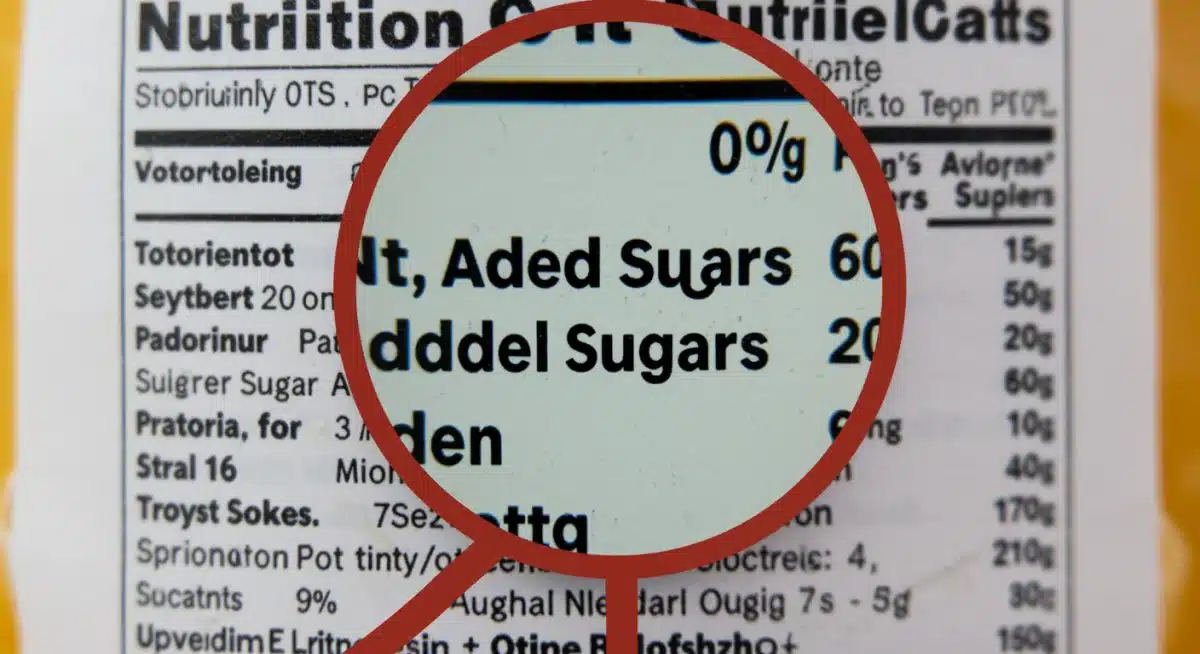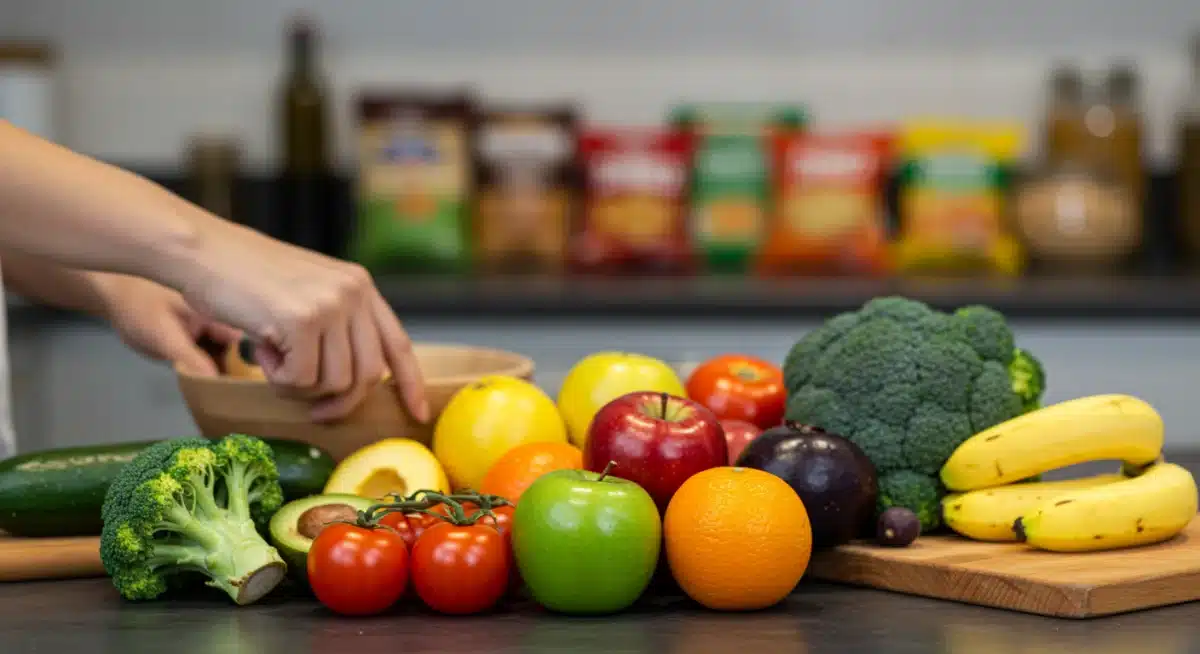Decoding Food Labels: Parent’s Guide to Added Sugars (2025)

Advertisement
Understanding food labels for added sugars is crucial for parents seeking to make informed dietary decisions and promote healthier eating habits for their families in 2025 and beyond.
Navigating the grocery store can often feel like a treasure hunt, especially when you’re trying to make the best dietary choices for your family. With constant updates to nutritional guidelines and an ever-evolving market, understanding what’s truly in our food is more important than ever. This guide is designed to empower you in Decoding Food Labels: A Parent’s Guide to Understanding Added Sugars (Updated 2025), ensuring you can confidently identify and manage the sweet culprits hidden within everyday products. Let’s embark on this journey to healthier eating together.
Advertisement
The Hidden Truth: Why Added Sugars Matter
Added sugars are not naturally present in foods but are incorporated during processing to enhance flavor, texture, or shelf life. These sugars, unlike those found naturally in fruits or dairy, offer little to no nutritional value and can have significant health implications, especially for growing children.
Understanding the impact of excessive added sugar consumption is the first step towards making healthier choices. It’s not just about avoiding obvious sweets; it’s about recognizing the subtle ways sugar infiltrates our daily diet.
Advertisement
Health Risks Associated with High Sugar Intake
A diet high in added sugars can contribute to a range of health issues, affecting both short-term well-being and long-term development. Awareness of these risks motivates parents to scrutinize food labels more carefully.
- Weight Gain and Obesity: Excess sugar is often stored as fat, contributing to unhealthy weight gain.
- Type 2 Diabetes: Consistent high sugar intake can lead to insulin resistance, increasing diabetes risk.
- Dental Cavities: Sugars feed bacteria in the mouth, leading to tooth decay.
- Heart Disease Risk: Studies link high sugar consumption to increased levels of unhealthy cholesterol and triglycerides.
- Energy Crashes and Mood Swings: Rapid spikes and drops in blood sugar can affect a child’s energy and behavior.
Recognizing the serious implications of added sugars helps us prioritize label reading and make informed decisions. It’s about protecting our children’s health from an early age, establishing habits that will serve them well into adulthood.
Navigating the Nutrition Facts Label: What’s New in 2025
The Nutrition Facts label has undergone significant updates to make it easier for consumers to understand and identify key nutritional information, particularly regarding sugars. These changes are crucial for parents trying to manage their family’s sugar intake.
The most notable change for 2025 is the prominent display of “Added Sugars” in grams and as a percentage of the Daily Value (%DV). This allows for a clear distinction between naturally occurring sugars and those added during processing.
Key Elements to Look For
Beyond the “Added Sugars” line, several other elements on the label provide valuable context. It’s a holistic approach to understanding a product’s nutritional profile.
- Serving Size: Always check the serving size and servings per container. Nutritional information is based on one serving.
- Total Carbohydrates: This includes fibers, naturally occurring sugars, and added sugars.
- Dietary Fiber: Foods high in fiber can help slow down sugar absorption and contribute to satiety.
- Ingredients List: This is where you’ll find the specific names of added sugars.
By focusing on these updated label features, parents can quickly gauge the sugar content of a product and compare it with other options. This shift in labeling empowers consumers to make more transparent and healthier food choices.

The Many Faces of Sugar: Identifying Hidden Sweeteners
Manufacturers often use various names for added sugars to make them less obvious on ingredient lists. This practice can make it challenging for even the most diligent parent to identify all sources of sugar.
Becoming familiar with these alternative names is a powerful tool in your arsenal for reducing your family’s sugar consumption. It’s about looking beyond the obvious “sugar” and recognizing its many disguises.
Common Aliases for Added Sugars
The list of sugar names can be extensive, but focusing on the most common ones will cover a significant portion of processed foods. Remember, if it ends in “-ose,” it’s likely a sugar.
- Syrups: High-fructose corn syrup, corn syrup, rice syrup, malt syrup, maple syrup, agave nectar.
- Concentrates: Fruit juice concentrate, date fruit concentrate.
- Maltodextrin and Dextrose: Often used as thickeners or sweeteners.
- Molasses and Caramel: While natural, they are still added sugars when not naturally occurring in the food.
- Sucrose, Glucose, Fructose, Lactose, Maltose: These are basic sugar forms.
Reading the ingredient list thoroughly, especially for items where sugar is listed among the first few ingredients, is key. Ingredients are listed in descending order by weight, so if sugar or its aliases appear early, the product contains a significant amount.
Don’t be fooled by labels that claim to be “natural” or “organic” – these products can still contain substantial amounts of added sugars under different names. Always check the ingredient list, regardless of marketing claims, to ensure you’re making the best choice for your family.
Practical Strategies for Reducing Added Sugar Intake
Once you’ve mastered identifying added sugars, the next step is to implement practical strategies for reducing them in your family’s diet. This doesn’t mean eliminating all treats, but rather making mindful choices and finding healthier alternatives.
Small, consistent changes can lead to significant improvements over time. It’s about building sustainable habits rather than enforcing strict, temporary restrictions.
Effective Tips for Parents
Incorporating these tips into your daily routine can make a big difference in managing your family’s sugar consumption. Education and consistent effort are paramount.
- Prioritize Whole Foods: Focus on fresh fruits, vegetables, lean proteins, and whole grains, which are naturally low in added sugars.
- Cook More at Home: Preparing meals from scratch gives you full control over ingredients, including sweeteners.
- Dilute Sweetened Beverages: Gradually dilute fruit juices or sweetened drinks with water to reduce sugar content.
- Offer Naturally Sweet Snacks: Opt for fruits, plain yogurt with berries, or unsweetened applesauce instead of sugary snacks.
- Educate Your Children: Explain why limiting sugar is important in an age-appropriate way, fostering their understanding and cooperation.
Reducing added sugars is a journey, not a destination. Celebrate small victories and be patient with yourselves and your children as you transition to a lower-sugar diet. The long-term health benefits are well worth the effort.

Beyond the Label: Understanding %Daily Value for Sugars
While the “Added Sugars” line in grams is helpful, the %Daily Value (%DV) provides an even clearer picture of how a product contributes to a child’s total daily sugar intake. The %DV is based on a 2,000-calorie daily diet, which is a general guide.
For children, their caloric needs may vary, but the %DV still serves as a useful benchmark. A general rule of thumb is that 5% DV or less is low, while 20% DV or more is high.
Interpreting %DV for Added Sugars
Understanding what %DV means in practical terms helps parents make quick decisions in the grocery aisle. It’s a simplified way to compare products at a glance.
- Low %DV (5% or less): Indicates a product with a relatively small amount of added sugars per serving.
- High %DV (20% or more): Suggests a product is a significant source of added sugars, and consumption should be limited.
- Moderation: For values between 5% and 20%, consider the overall diet and other sources of sugar.
It’s important to remember that the %DV for added sugars is meant to help consumers stay within recommended limits. The Dietary Guidelines for Americans recommend that children over two years old consume less than 10% of their daily calories from added sugars. This translates to roughly 50 grams for a 2,000-calorie diet, or about 12 teaspoons.
By combining the grams of added sugars with the %DV, parents gain a comprehensive understanding of a product’s sugar content, enabling them to make more informed and health-conscious decisions for their family’s dietary needs.
Making Informed Choices: Empowering Your Family’s Health
Empowering yourself with the knowledge to decode food labels is a significant step towards fostering a healthier environment for your family. It’s about proactive health management and instilling good habits from a young age.
This journey isn’t just about avoiding sugar; it’s about embracing a lifestyle that prioritizes whole, nutritious foods and understanding the impact of every ingredient.
Long-Term Benefits of Reduced Sugar Intake
The efforts you make today in managing added sugars will yield long-term benefits for your children’s health, development, and overall well-being. These benefits extend beyond physical health.
- Improved Overall Nutrition: Reducing sugar often means replacing it with more nutrient-dense foods.
- Better Weight Management: Lower sugar intake supports healthy weight and reduces obesity risk.
- Enhanced Focus and Energy: Stable blood sugar levels contribute to better concentration and sustained energy.
- Reduced Risk of Chronic Diseases: A lower sugar diet can decrease the likelihood of developing conditions like type 2 diabetes and heart disease later in life.
- Healthier Relationship with Food: Children learn to appreciate natural flavors and develop a balanced approach to eating.
By consistently applying the strategies for decoding food labels and making conscious choices, you are not just reducing sugar; you are cultivating a foundation for lifelong health and well-being for your entire family. This proactive approach ensures a healthier future for your children.
| Key Aspect | Brief Description |
|---|---|
| Updated Labels | New 2025 Nutrition Facts clearly show “Added Sugars” in grams and %DV. |
| Hidden Names | Sugars hide under names like syrups, concentrates, and specific “-ose” endings. |
| Reading %DV | 5% DV is low, 20% DV is high; use to gauge daily sugar contribution. |
| Reduction Strategies | Prioritize whole foods, home cooking, and natural sweeteners to reduce intake. |
Frequently Asked Questions About Added Sugars
Natural sugars are intrinsically found in whole foods like fruits and milk, often accompanied by fiber and nutrients. Added sugars are sweeteners and syrups put into foods during processing or preparation, offering empty calories without significant nutritional benefits.
The 2025 labels prominently display “Added Sugars” in grams and as a percentage of the Daily Value. This makes it much easier for parents to quickly identify how much sugar has been added to a product, distinct from naturally occurring sugars, aiding in healthier choices.
Hidden sugars can appear as high-fructose corn syrup, corn syrup, dextrose, glucose, sucrose, maltose, fruit juice concentrate, agave nectar, molasses, and many others. Always look for ingredients ending in “-ose” or various “syrups” and “concentrates.”
For children over two years old, health guidelines recommend consuming less than 10% of their daily calories from added sugars. This typically translates to about 50 grams or 12 teaspoons for a 2,000-calorie diet, but individual needs may vary.
Not necessarily. While some natural sweeteners like honey or maple syrup offer trace nutrients, they are still forms of added sugar and should be consumed in moderation. “Organic” simply refers to how they are processed, not their caloric or sugar content. Always check the label.
Conclusion
As parents, our commitment to our children’s health is unwavering, and understanding nutrition labels, especially concerning added sugars, is a vital part of that commitment. The updated 2025 food labels provide clearer insights, but true empowerment comes from knowing what to look for, recognizing hidden sugars, and implementing practical strategies for reduction. By making informed choices, prioritizing whole foods, and fostering open conversations about healthy eating, we can significantly impact our families’ well-being, setting them on a path toward a healthier, happier future. This guide aims to be your trusted companion in navigating the complexities of modern food, ensuring every meal contributes to a vibrant, energetic family life.





